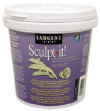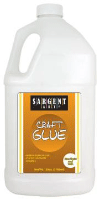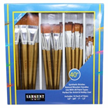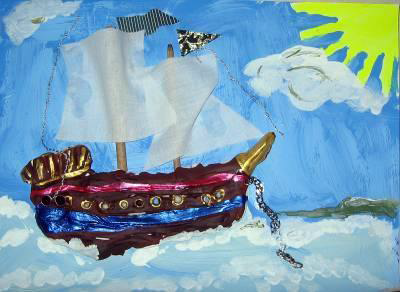Goal (Terminal Objective):
Sculpture/Collage
Objective:
Students will become aware of processes, techniques, and media variety used in art forms to communicate ideas. Students will perceive how technique, balance, and texture function in a work of art. Students will be able to identify characteristics of sculptural art forms. Students will analyze sculpture to better understand techniques utilized in specific works of art.
National Standards:
Visual Arts Grades K4 Content Standard 1: Understanding and applying media, techniques, and processes
Visual Arts Grades K4 Content Standard 2: Using knowledge of structures and functions
Visual Arts Grades K4 Content Standard 3: Choosing and evaluating a range of subject matter, symbols, and ideas
Visual Arts Grades K4 Content Standard 4: Understanding the visual arts in relation to history and cultures
Purpose:
Students will determine that collages are art works made of collected materials. Students will identify relief sculpture and will compare and contrast with freestanding sculpture. Students will compare and contrast various seascapes. Suggested exemplars are Thomas Eakins, “Turning the Stake”; Robert Gwathmey, “Soft Crabbing”; Winslow Homer, “Breezing Up”; Childe Hassam, “Oyster Sloop”.
Students will identify parts of a ship, discuss the value of maps in navigation, and discuss the use of a ships log.
Students will create a relief sculpture on a painted seascape background. Further exploration on this theme would be to create a navigational map and make a journal page in the form of a ship’s log.
New Vocabulary:
seascape, distance, perspective, horizon line, background, middle ground, foreground, depth, 2d plane, texture, simulate, relief, freestanding sculpture, boom, hull, mast, sail, porthole, stern, bow
Materials:

#22-22xx Fluorescent Acrylic Paint

#22-2000 Sculpt-It! White Re-sealable Tub air-hardening material

#22-1206 set Metallic Acrylic Paint

#22-1105 Craft Glue

#23-9111 11 ct. Sculpting Tool Set

#56-3101 40 ct. Flat Jumbo Brush Best-Buy Set
Illustration board/white tag, white fabric, scraps of ribbon, toothpicks, wood dowels
Time:
This lesson may be modified from two to five hours, depending upon the size and complexity of expectations
Introduction and Motivation (Set):
Review and broaden students’ knowledge of sculpture. Compare the difference between two dimensional shapes and threedimensional forms. Identify basic forms used in sculpture. Discuss the variety of materials used by artists to make sculptural forms. Discuss students’ prior knowledge in viewing and creating threedimensional art forms.
View pictures of seascapes. Discuss the parts of a seascape and the parts of sixteenth century vessels and square rigged ships.
Discuss the importance of ships as a mode of transportation during the early years of exploration and settlement of our country.
Discuss how artists often make sketches by drawing light lines of main shapes before drawing details.
Instruction:
Provide fine art exemplars for analyzation. Read stories about ships. View exemplars. Discuss lifestyle, work leisure activities, time of day, realistic vs. abstract, mood. Students use journal to record observations.
Read The Wretched Stone by Chris Van Allsburg. Carefully view the illustrations and seascape exemplars as points of a discussion of the elements and principles of organization.
Discuss the use of a ship’s log. Provide writing prompts for students to model as they generate their own ship’s log detailing activities on their ship. View examples of antique maps. Discuss compass and legend as it refers to map making. View diagram of a ship, refer to terms listed on diagram.
Compare and contrast student drawings with artist exemplars as to technique, style, patterning, composition. Record the comparisons in journals.
Activities:
(1) Guided Practice:
- Students make lists of what objects will be in their seascapes. Students create sketches for their ship’s hull.* Select final sketch of hull, cut out for pattern to use on seascape painting.

- Students use tag board or poster board as a background for a seascape painting using Sargent Acrylics. Focus on tints and shades in color selection.


- Students apply Sculptit to boat hull pattern, building up forms in relief. Pencil point can be used as a clay tool to add details, such as railings, wood grain, or portholes.


- Paint dried boat hull with various values of brown. Use Sargent metallic paint for accents on the boat hull. Liquid Metal markers may be used for details.

- 5. Use Sargent white glue to glue boat hull to seascape background. Add masts of wood dowels, a toothpick for a bowsprit, boom, small pieces of white fabric for sails, and pieces of ribbon for flags atop the masts. A crow’s nest may be added using a small piece of SculptIt.

(2) Independent Practice and Check for Understanding: Teacher circulates among working students visually recording students demonstrating understanding of objectives and provides reinforcement. Teacher will assist them in focusing on the idea of drawing main shapes and main structural lines of objects.
(3) Closure: Students record either by checklist or writing prompt, the symbols used, the connection to the exemplar, and the innovations they provided to their composition.* Review new vocabulary. Generate a “ship’s log” of events that happened on their ship. Create a “Treasure Map” using a legend and compass rose to illustrate direction.
Evaluation:
Teacher/student critique. Individual Evaluation: Describe what forms they used to create their collage; Describe how depth was created in the seascape; Analyze why certain materials were used in the creation of this work of art.
Extension:
This strategy may be extended to providing additional collage items.
Resources:
http://www.mayflowerhistory.com/
http://en.wikipedia.org/wiki/Mayflower
http://teacher.scholastic.com/thanksgiving/voyage/
http://www.abc.se/~m10354/bld/shiptype.htm
http://www.woodentallships.com/16thcenturyships.htm
Art Consultant



